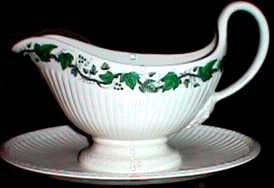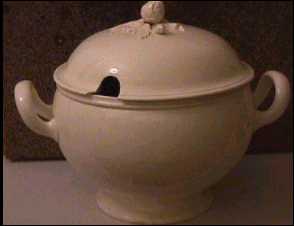![]()
Creamware
|
Creamware |
|
![]()
![]() The cream colour was considered a fault at the time, and Wedgwood
introduced a white to bluish white product called pearl ware in 1779. It was
produced for nearly a century. Creamware, however, continued to be made
throughout the 19th century and later.
The cream colour was considered a fault at the time, and Wedgwood
introduced a white to bluish white product called pearl ware in 1779. It was
produced for nearly a century. Creamware, however, continued to be made
throughout the 19th century and later.
![]() It was Josiah Wedgwood who made a great commercial
success with this cheap, utilitarian ware, which he made at Burslem
from about 1762.
It was Josiah Wedgwood who made a great commercial
success with this cheap, utilitarian ware, which he made at Burslem
from about 1762.
![]() Wedgwood also attracted the patronage of Queen
Charlotte, who allowed him to adopt the name Queen's ware.
His most considerable effort was a creamware dinner service of 952 pieces
supplied to Catherine II the Great of Russia in 1775.
Wedgwood also attracted the patronage of Queen
Charlotte, who allowed him to adopt the name Queen's ware.
His most considerable effort was a creamware dinner service of 952 pieces
supplied to Catherine II the Great of Russia in 1775.

Wedgwood Creamware Gravy Boat and Saucer in the
"Stratford" Pattern. The Gravy and saucer are attached.
The saucer is 9 1/2" long and the top of the
gravy is 8" to the top of the handle.
The piece is a total of 3 3/4" high. The pattern has a border of green ivy.

An enormous creamware soup tureen.
It is 19th century. It is 16 inches wide and just over 12 inches tall.
It is from the Zell ceramic atelier in Zell Germany
and was produced after 1818 and before 1869.
![]()
questions / comments? email Steve Birks steveb@netcentral.co.uk